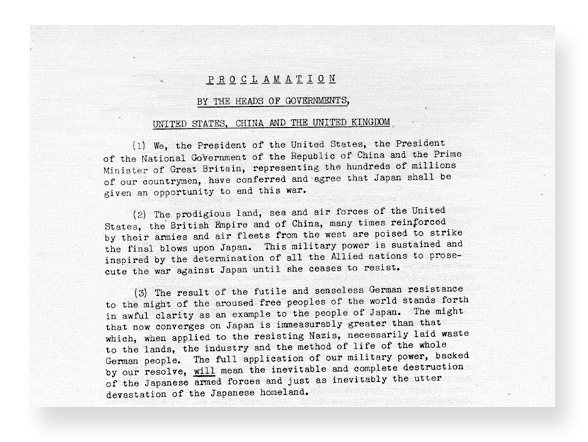WWII 75: Marching to Victory | July 26, 2020

WWII highlights from the Truman Library’s archives and collections
Marching to Victory: The Potsdam Declaration
July 26, 1945
By July 1945, Japan was defeated nearly everywhere except in the hearts and minds of the Japanese. Even as the Japanese Empire crumbled and the suffering Japanese prepared for invasion, military leaders reminded their people that national honor prohibited surrender to the Allies.
On July 26, however, the leaders of the United States, the Republic of China, and Great Britain demanded that Japan do that very thing. In the Potsdam Declaration, they promised a vague yet dire scenario for the Japanese should they refuse to yield. U. S. President Harry Truman, the main architect of the document, was not optimistic but noted in his diary that the Allies were giving the Japanese a chance “to surrender and save lives.”
The Declaration began by offering Japan an escape from Armageddon. “The full application of our military power, backed by our resolve, will mean the inevitable and complete destruction of the Japanese armed forces and just as inevitably the utter devastation of the Japanese homeland”—unless the nation surrendered now. “The time has come for Japan to decide whether she will continue to be controlled by those self-willed militaristic advisers whose unintelligent calculations have brought the Empire of Japan to the threshold of annihilation, or whether she will follow the path of reason.”
The three Allied powers next laid out their terms. Japan must end “for all time the authority and influence of those who have deceived and misled the people of Japan into embarking on world conquest, for we insist that a new order of peace, security and justice will be impossible until irresponsible militarism is driven from the world.” The Allies would occupy Japan’s outlying territory until these leaders were removed and the country disarmed and Japanese soldiers returned home “to lead peaceful and productive lives.”
“We do not intend that the Japanese shall be enslaved as a race or destroyed as a nation,” the Declaration continued, “but stern justice shall be meted out to all war criminals, including those who have visited cruelties upon our prisoners.” Japan’s government also had to soften its rigidly autocratic system, permit democracy, and protect human and political rights.
The Allies pledged to help the Japanese rebuild their war-ravaged economy. All industry was allowed except that for war-making. “To this end, access to, as distinguished from control of, raw materials shall be permitted. Eventual Japanese participation in world trade relations shall be permitted.” Once the Japanese met the Allied terms and formed a democratic government, occupying troops would depart.
The Declaration ended with ominous words that have echoed ever since. “We call upon the government of Japan to proclaim now the unconditional surrender of all Japanese armed forces, and to provide proper and adequate assurances of their good faith in such action. The alternative for Japan is prompt and utter destruction.”
The Potsdam Declaration thus gave the Japanese a way out of the war that avoided complete ruin and unconditional surrender. Tragically, Prime Minister Suzuki Kantaro and Japan’s military leaders ignored the ultimatum, sealing the fate of hundreds of thousands of their countrymen. In the coming weeks, the Japanese would learn what the Allies meant by “prompt and utter destruction.”
The Harry S. Truman Library and Museum’s digital archives includes this reproduction of the Potsdam Declaration.
More to Explore
- Relive history in The White House Decision Center. Step back to 1945 and into the roles of President Truman, J. Robert Oppenheimer and other West Wing advisors. How will WWII end? You decide.
Marching to Victory
75 years ago, World War II ended under President Truman’s decisive leadership. Now, follow key events from the war’s final months with the Truman Library Institute’s series, “Marching to Victory: WWII Highlights from the Truman Library’s Archives and Collections.” The 25-part blog series opens the vaults at Truman’s presidential library to share eyewitness accounts and historic artifacts related to major conflicts and monumental victories – from the Battle of the Bulge to the liberation of Dachau to the unconditional surrender of Japan.
More in this series:
Marching to Victory: The Bombing of Dresden
Marching to Victory: The Yalta Conference
Marching to Victory: The Battle of the Bulge
Marching to Victory: The Tokyo Fire Raids
Marching to Victory: The Battle of Okinawa
Marching to Victory: The Liberation of Buchenwald
Marching to Victory: “The President is Dead”
Marching to Victory: The Liberation of Dachau
Marching to Victory: The Death of Adolf Hitler
Marching to Victory: Germany Surrenders!
Marching to Victory: Victory Gardens
Marching to Victory: Civil Rights
Marching to Victory: The United Nations
Marching to Victory: How Children Helped Win the War
Marching to Victory: The First Atomic Bomb Test
Marching to Victory: The Potsdam Conference
Contributed by Will Hickox, Ph.D. He has written for The New York Times and contributed to several digital history projects.
Join our email list to receive Truman updates right in your inbox:



